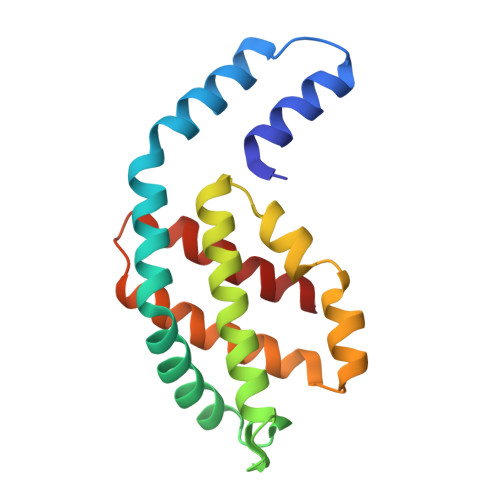Crystallographic and biochemical analyses of a far-red allophycocyanin to address the mechanism of the super-red-shift.
Zhou, L.J., Hoppner, A., Wang, Y.Q., Hou, J.Y., Scheer, H., Zhao, K.H.(2024) Photosynth Res 162: 171-185
- PubMed: 38182842
- DOI: https://doi.org/10.1007/s11120-023-01066-2
- Primary Citation of Related Structures:
8OR7 - PubMed Abstract:
Far-red absorbing allophycocyanins (APC), identified in cyanobacteria capable of FRL photoacclimation (FaRLiP) and low-light photoacclimation (LoLiP), absorb far-red light, functioning in energy transfer as light-harvesting proteins. We report an optimized method to obtain high purity far-red absorbing allophycocyanin B, AP-B2, of Chroococcidiopsis thermalis sp. PCC7203 by synthesis in Escherichia coli and an improved purification protocol. The crystal structure of the trimer, (PCB-ApcD5/PCB-ApcB2) 3 , has been resolved to 2.8 Å. The main difference to conventional APCs absorbing in the 650-670 nm range is a largely flat chromophore with the co-planarity extending, in particular, from rings BCD to ring A. This effectively extends the conjugation system of PCB and contributes to the super-red-shifted absorption of the α-subunit (λ max = 697 nm). On complexation with the β-subunit, it is even further red-shifted (λ max, absorption = 707 nm, λ max, emission = 721 nm). The relevance of ring A for this shift is supported by mutagenesis data. A variant of the α-subunit, I123M, has been generated that shows an intense FR-band already in the absence of the β-subunit, a possible model is discussed. Two additional mechanisms are known to red-shift the chromophore spectrum: lactam-lactim tautomerism and deprotonation of the chromophore that both mechanisms appear inconsistent with our data, leaving this question unresolved.
- National Key Laboratory of Agricultural Microbiology, Huazhong Agricultural University, Wuhan, 430070, The People's Republic of China.
Organizational Affiliation:




















